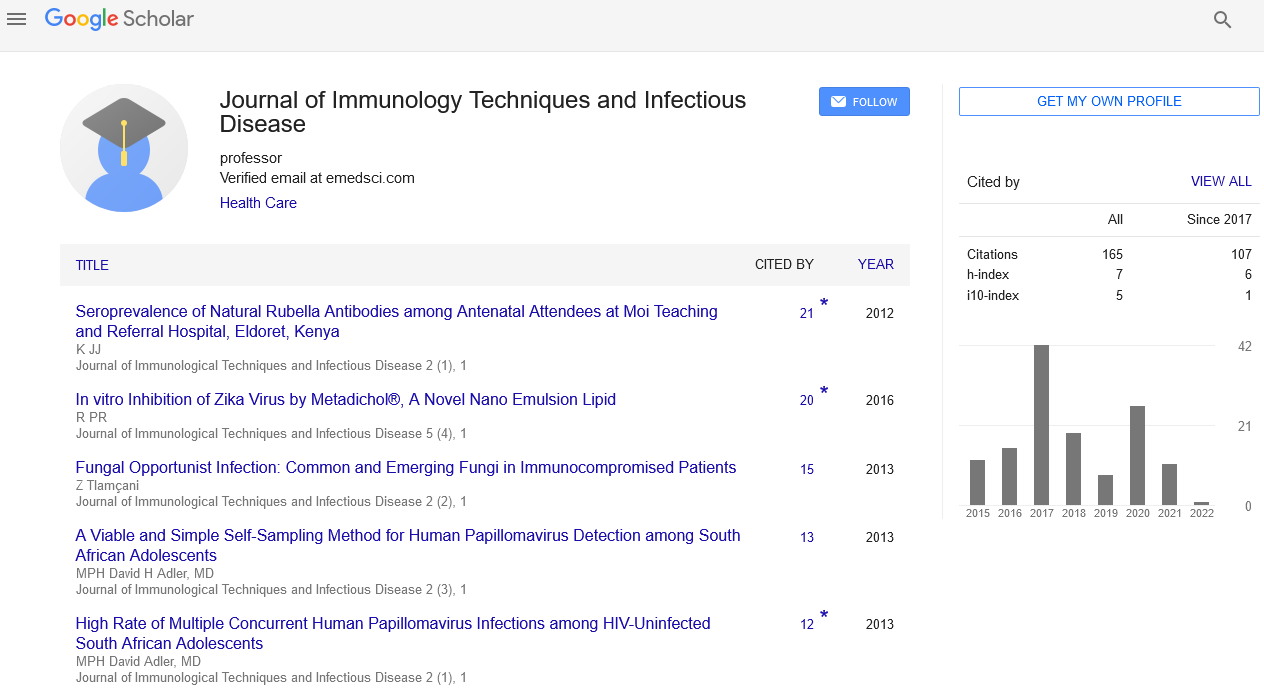Opinion Article, J Immunol Tech Infect Dis Vol: 12 Issue: 1
Cryptosporidiosis in Children: Diagnosis and Treatment
Qing Huan*
Department of Chemistry, Hong Kong University of Science and Technology,Clear Water Bay, Hong Kong
*Corresponding Author: Qing Huan
Department of Chemistry, Hong Kong University of Science and Technology, Clear Water Bay, Hong Kong
E-mail: qinghuan@123.com
Received date: 01-Feb-2023, Manuscript No. JIDIT-23-94472;
Editor assigned date: 03-Feb-2023, PreQC No. JIDIT-23-94472 (PQ);
Reviewed date: 17-Feb-2023, QC No. JIDIT-23-94472;
Revised date: 24-Feb-2023, Manuscript No. JIDIT-23-94472 (R);
Published date: 03-Mar-2023, DOI: 10.4172/2329-9541.1000335.
Citation: Huan Q (2023) Cryptosporidiosis in Children: Diagnosis and Treatment. J Immunol Tech Infect Dis 12:1.
Description
Cryptosporidiosis is a parasitic disease caused by the microscopic parasite Cryptosporidium. It is a common cause of diarrheal illness in humans and animals, and can be transmitted through contaminated water, food, or contact with infected individuals or animals. Cryptosporidium enters digestive system through mouth, where it reproduces and causes symptoms. Cryptosporidium is a protozoan parasite, which is a one-celled creature that feeds on animals and humans. Cryptosporidium hominis and Cryptosporidium parvum are the most common types of crypto that infect humans.
Symptoms of cryptosporidiosis typically include diarrhea, stomach cramps, nausea, and vomiting. In healthy individuals, symptoms usually last for about one to two weeks, but can be more severe in those with weakened immune systems. People may occasionally experience a relapse of symptoms after a brief period of recuperation before the sickness is over. Symptoms can appear and disappear for up to 30 days. While the small intestine is the most usually afflicted region, Cryptosporidium infections can affect other parts of the digestive system or the respiratory tract in immunocompromised people.
Cryptosporidiosis is a global health concern, particularly in developing countries where access to clean water and proper sanitation is limited. Outbreaks of cryptosporidiosis have been linked to contaminated drinking water, swimming pools, and food sources. Cryptosporidiosis is transmitted by the fecal-oral route, which means catch it by accidently eating parasite-infested stool (faeces). Cryptosporidiosis spreads quickly from infected individuals or animals. Drinking unclean water and ingesting water from lakes, swimming pools, water parks, or other recreational water places are examples of this. Chlorine does not destroy Cryptosporidium and is responsible for the majority of illness outbreaks at public pools. This is the most prevalent route for people to contract cryptosporidiosis. Food that has been tainted unwashed fruits and vegetables, unpasteurized apple cider, unpasteurized milk, and food produced with unpasteurized milk are all examples.
Items and surfaces that have been contaminated this includes contacting goods and surfaces that someone with cryptosporidiosis has touched, caring for someone with cryptosporidiosis (including children), and changing diapers. Animals that have been infected touching farm animals and stroking zoo animals can spread cryptosporidiosis.
Prevention and treatment of cryptosporidiosis involves proper sanitation and hygiene practices, such as frequent hand washing and avoiding contact with infected individuals or animals. There is currently no specific treatment for cryptosporidiosis, but symptoms can be managed through rehydration and supportive care. In persons with healthy immune systems, antiprotozoal medicine can also be used to treat cryptosporidiosis. Antiprotozoal drugs prevent protozoa such as Cryptosporidium from multiplying in body.
Conclusion
To develop more effective treatments and prevention methods for cryptosporidiosis however, it remains a significant health concern, particularly in vulnerable populations such as young children, the elderly, and those with weakened immune systems cryptosporidiosis is a parasitic disease that can cause significant illness and is a global health concern. Proper sanitation and hygiene practices are essential in preventing the spread of the disease, particularly in developing countries where access to clean water and sanitation is limited. While treatment options are limited, ongoing research and prevention efforts are essiential in addressing this important public health issue.
 Spanish
Spanish  Chinese
Chinese  Russian
Russian  German
German  French
French  Japanese
Japanese  Portuguese
Portuguese  Hindi
Hindi 
